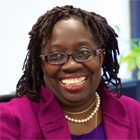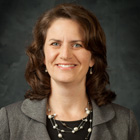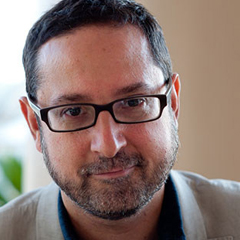It’s hurricane season, and communities in the Southeastern United States are just setting out on the hard road to recovery from the destructive force of Florence. LISC has years of experience partnering with local groups to help residents rebuild, and stewarding funds to get that complex work done more efficiently and effectively. In a roundtable interview, four of our resident experts offer reflections and critical best practices for rebuilding, plus a list of the top five things to do post-disaster.
Top photo: Puerto Rico post Hurricane Maria © Nashish Scott
Four LISC staff, each with deep experience in rebuilding homes, businesses and communities in the wake of natural disasters, share insights and best practices for engaging in this complex process.
 Denise Scott
Denise Scott
LISC executive vice president for programs who previously served as executive director of LISC New York City
 Amanda Timm
Amanda Timm
Former executive director of LISC Houston
 Sam Marks
Sam Marks
Former executive director of LISC New York City
 Anna Hurt
Anna Hurt
Program officer in charge of disaster recovery and resilience for Rural LISC, which works in 2,000 counties across 44 states
In the wake of a hurricane or other disaster, you have a life-or-death emergency that, in time, morphs into a long-term development project. Where does LISC get involved?
Denise Scott: LISC’s work in disasters goes back to before Katrina [New Orleans & the Gulf Coast, 2005]. In the early days, we would get involved in the emergency response, handing out supplies, just joining the crowd of people who volunteered to help. But that quickly morphed into a much deeper, comprehensive role, aligned with LISC's mission. By 2007, we were co-managing a $47 million public-private fund that helped create or rehab 4,500 affordable homes in Louisiana.
When Sandy hit [New York and New Jersey, 2012], I recognized that the most important role for LISC is to think about the long game—how to help communities rebuild. So most of our activities these days are designed around rebuilding and deploying money for that. We start by quickly assessing the local market—that includes the county, state, our not-for-profit partners, developers, that whole ecosystem of players—to figure out their capacity to respond to long-term rebuilding and then continue efforts to support the flow of capital to communities through partnerships with government around the use of CDBG-DR funds.
And then we begin conversations around assembling capital. At the outset, we really focus philanthropic dollars because that’s the first money to flow. We establish funds to support rebuilding.
After Harvey, for example, the Red Cross reached out to us for help rebuild homes. I talked to the city, talked to the state, talked to a few foundations, and then came back to all of them and said, ‘Ok, we’re prepared to start with renovating up to 400 single-family homes using the Red Cross’ and others’ funds.’ You make a declaration, ‘Here’s what we want to do.’ And then it evolves and support grows—the Red Cross has already increased their funding for the program. The next phase of our Harvey recovery work will focus on multi-family buildings.
Sam Marks: It typically does take quite a long time, maybe 18 months, for the federal Community Development Block Grant Disaster Recovery dollars to start moving. We’re able to be first movers on the recovery side because LISC can be an immediate place for that philanthropic capital to land and move quickly in advance of the public dollars.
After Sandy, with about $15 million in private donations, the first program we put in place in New York City was for mold treatment in homes, and that morphed into a home-repair program focused on single-family home fixes.

Because it was private dollars, we were able to adapt our expertise and relationships in weatherization, build up the infrastructure, and do it ourselves. We did mold treatment in 2,000 homes, and repaired 501 homes for low-income homeowners in an average of just 120 days—from intake to sign-off on a finished job. We could create something small and nimble and responsive, and we had staff who really cared walking individual homeowners through a process from soup to nuts.
We also did a lot of grant making to nonprofit organizations on the ground in neighborhoods to help residents begin to navigate the various bureaucracies to get federal benefits.
One of LISC’s roles in community development is capacity building at various levels. What does that mean in the context of disaster recovery?
Denise Scott: During the months after a disaster hits, we’re working on helping the whole community—contractors, not-for-profits, the average resident, local governments—get ready to become part of the rebuilding efforts.
In many places—this is true of Puerto Rico and the U.S. Virgin Islands but it’s also true in Houston—local government is not as prepared for long-term rebuilding. They can get prepared but they’ve got to put the infrastructure in place.
If, say in Puerto Rico, you’re used to getting less than a billion dollars of CDBG money every year and now you’re going to get $20 billion, well, you don’t quite have the back office to support that. It’s a good problem to have, but it’s a problem nonetheless.
And we always think about opportunities for jobs: how can we connect residents to jobs that will emerge out of the rebuilding effort?
Amanda Timm: The Harvey Jobs Initiative here in Houston is a good example of that. Last August when Hurricane Harvey created $125 billion in damage over a massive area, we knew there was a lot of work to be done. We already had a network of Financial Opportunity Centers (FOCs) that coach low-income people in career planning and financial management. We understood a lot of those clients would need new employment. So the FOCs started offering specific trainings fine-tuned to recovery work. Off the bat, for example, some of them started offering drywall training.
We also provided funding to a partner that works with small contractors to help them go from being mom-and-pop operations running everything from the dashboard of their pickup to having systems that will allow them to scale up and be more competitive for bigger jobs.
As you've all noted, response to natural emergencies involves lots of players, from community groups to local government agencies to philanthropic organizations. How do you coordinate with these partners when the stakes and tensions are so high, and the task at hand so daunting?
Anna Hurt: Relationships drive success in any program—anything you do—and I think that’s never more true than when you’re working in disaster recovery. It’s really important that you have those relationships before you’re in the middle of working really exhausting days, that you know before a disaster happens who’s doing what and where and how to get a hold of each other.
I’ve relied on those relationships as I’ve figured things out in different environments. For example, before I joined LISC, after Harvey, I got a phone call from Pepsi saying, ‘Hey, we have all these trailers of water and Gatorade, we just need to know where to go.’ I wouldn’t have been able to help if I hadn’t known exactly who to call at Feeding America and get information about where roads were open to food banks. Those relationships all happened before Harvey ever hit the ground. Those are your best buddies, you never let them go.
I think, too, the broad coordination calls that happen around housing and long-term recovery, are important as a universal update because they keep everybody networked even through staff changes and things getting really busy.
Amanda Timm: Immediately after Harvey, as the rain was stopping, we at Houston LISC played a convening role to pull together all of our grantees and borrowers and figure out how to get information to and from community frontline agencies so they could make good decisions. We started with a phone call and then we were gathering people, weekly for a bit and then biweekly. It was just, ‘Show up and we’ll figure out stuff together.’ There was so much information swirling but it was difficult to make sense of it, and also hard to get good information. Our gatherings became a place where people said they could get the real story and define actionable steps they could take to serve their clients better.
They would form partnerships right there at our meetings. We’d find that ten people were having the same issue. And as a team member, LISC would dig into that, chase down that information so they could keep doing frontline work.
We know that natural disasters disproportionately impact people who are economically and socially vulnerable even in ordinary times. How does this insight guide our response?
Anna Hurt: When I’m doing my initial needs assessment, something I always pay attention to is the Social Vulnerability Index of the University of South Carolina, which maps social and economic vulnerabilities against environmental hazards in states. And I’ll always ask how community organizations look at their vulnerable groups. I’ll get a sense if they believe the needs of those groups are being met adequately. You ask that question of 15 people, you get a pretty good idea what the trend is.
Then you take the answers and build those into your recovery plan. If you know that older adults are being underserved and under-resourced—I‘m thinking specifically of Puerto Rico—and you’re working with housing and small businesses, then you build a plan that starts with housing and small businesses that serve those populations.
Denise Scott: One of the things that was clear about Sandy, and in New Orleans as well, was that the end of the month is the worst time a disaster could possibly hit for poor people. Because it’s after all of the monthly resources have been depleted. Folks literally didn’t have money to take a bus anywhere, they just were stuck.
So yes, we look for the most vulnerable, and that’s where the Red Cross and other philanthropic dollars tend to play out. We’re looking for the elderly, we’re looking for people with young families, for disabled families, we’re looking for immigrants with uncertain legal status who might not want to come out of the shadows.
We tell our funders, these are the people we target, because they may not be able to maneuver through the complicated government funding streams, or don’t qualify because they’re not citizens.
And when we touch a family, we make sure we’re not just looking at the house, we’re looking at their other needs as well. What we found about Sandy is that the storm revealed a set of ills—it tells us something about the way people live that probably wasn’t good in the first place. So we use that opportunity to make sure people are connected to other resources, to food stamps, to credit counseling or job training.
As an organization with nationwide reach, how does LISC connect with those local families in order to target programs and resources?
Sam Marks: As Anna described, it’s mainly through our ties to community-based organizations that were embedded in their neighborhoods before a hurricane or disaster strikes, and will be there long after the disaster fades from the news.
In disaster recovery there’s a set of large-scale players and contractors that really know how to interact with FEMA and HUD, the federal disaster agencies. What’s often missing are those connections to informal, on-the-ground networks that get activated in disasters.
For example, you have community groups in the immediate days after who know where there are concentrations of seniors up in multi-story buildings that don’t have elevators and don’t have electricity, and they mobilize to get food and resources to those people. Those are the types of players in neighborhoods that LISC has existing relationships with, and their work can mean the difference between life and death.
Amanda Timm: We saw that kind of informal network go to work in the initial days after Harvey. We did 11 small grants, just from money that we had, flexible dollars. We put out $5,000 apiece to a set of groups that we work with very closely, just so that they would have a little bit of money to do whatever they needed to do in the early days. We have also seen organized resident leader play critical roles in responding to their neighborhoods and nonprofit communit-based organizations build capacity in new types of services to respond to their community’s greatest needs.
Top 5 Things LISC Does in Disaster Recovery
1. Connect with partners on the ground
Community-based organizations know what’s up in their neighborhoods. LISC knows who they are and can help bolster their work after a disaster.
2. Establish a targeted fund or funds for recovery
Often leveraging existing relationships with philanthropic funders, LISC can get those dollars on the ground to get things done nimbly and humanely.
3. Be a conduit for municipal, state, and national recovery resources
Experienced in the regulatory, financial, logistical, and managerial challenges of large-scale community development projects, LISC can help put public recovery resources to work rebuilding neighborhoods and local economies.
4. Advocate best practices
This can mean pushing for more rigorous standards in mold remediation or fighting for better resiliency planning at the local level. Always and in every venue, it means insisting on transparency, equity, and the primacy of local voices in planning and carrying out recovery work.
5. Build capacity
Through trainings, technical assistance, and grant making, LISC can help a range of players from small businesses and community-based organizations to local governments gain the staff, systems, and expertise they need to tackle recovery work.